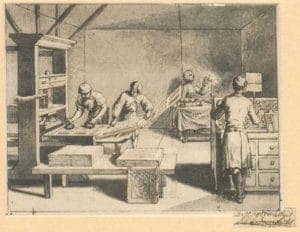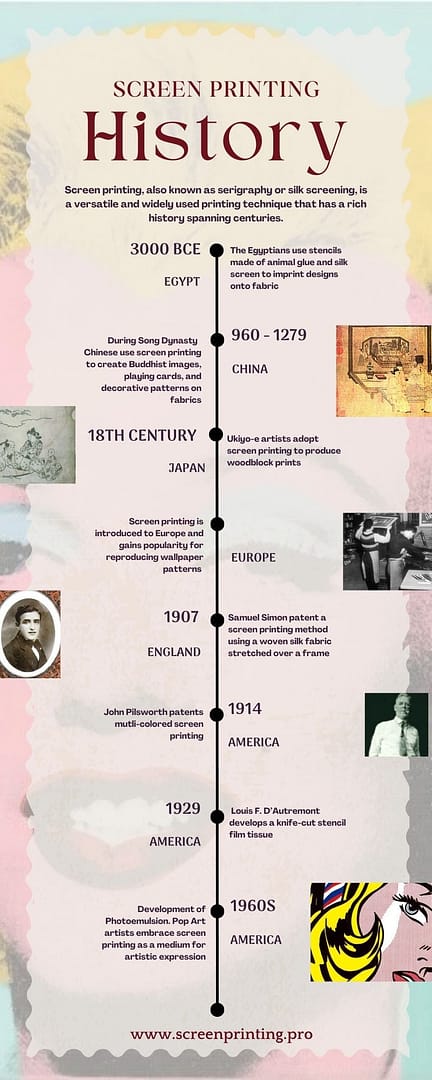Introduction to Screen Printing
Screen printing, also known as serigraphy or silk screening, is a versatile and widely used printing technique that has a rich history spanning centuries. This article delves into the fascinating journey of screen printing, tracing its origins, development, and applications over time. From ancient techniques to modern advancements, screen printing has evolved into a vital process in various industries, leaving an indelible mark on art, fashion, advertising, and more.
Early Beginnings of Screen Printing

Screen printing finds its roots in early stencil-based techniques used by ancient civilizations. The Egyptians, around 3000 BCE, utilized stencils made of animal glue and silk screens to imprint designs onto fabric. This method spread to other cultures, including China and Japan, where intricate stenciling techniques flourished.
Ancient Techniques and Origins
In China during the Song Dynasty (960-1279 CE), screen printing emerged as an art form. It was used to reproduce Buddhist images, playing cards, and decorative patterns on silk fabrics. Japan further developed the technique, known as katazome, using natural dyes and paper stencils to create vibrant designs.
Screen Printing in East Asia
The 18th century saw significant advancements in screen printing in East Asia. In Japan, ukiyo-e artists adopted screen printing to produce woodblock prints in large quantities. This innovation allowed for intricate designs with multiple colors, paving the way for more widespread use of screen printing.
Introduction to Europe and the West
Screen printing’s introduction to Europe dates back to the late 18th century when it reached England and France. The process gained popularity for reproducing wallpaper patterns and later expanded into other industries, such as textiles and ceramics. In the early 20th century, artists like Henri Matisse and Andy Warhol embraced screen printing for artistic expression.
Development of Modern Screen Printing
The early 1900s witnessed significant developments in screen printing technology. In 1907, Samuel Simon patented a screen printing method using a woven silk fabric stretched over a frame. This advancement led to the term “silk screening” and formed the foundation for modern screen printing techniques.
Screen Printing in the Industrial Revolution
During the Industrial Revolution, screen printing experienced a surge in demand. The ability to print large volumes of intricate designs on various materials, including textiles and metal, made screen printing an invaluable tool for mass production. It found widespread use in advertising, signage, and packaging industries.
Screen Printing in the 20th Century
The 20th century witnessed further advancements in screen printing. In the 1960s, the development of photoemulsion revolutionized the process, allowing for more detailed and precise designs. Artists and designers embraced screen printing as a medium for artistic expression, contributing to its popularity and diversification.
Advancements in Screen Printing Technology
Advances in technology have continuously propelled screen printing forward. Innovations like computerized stencil cutting, automated screen exposure, and digital printing have streamlined the process and increased its efficiency. New types of inks, including water-based and eco-friendly options, have also emerged, catering to changing environmental considerations.
Applications of Screen Printing
Screen printing’s versatility has made it a sought-after technique in various fields. It plays a vital role in textile printing, allowing for intricate designs on fabrics, garments, and accessories. The advertising industry utilizes screen printing for signage, banners, and promotional items. Additionally, screen printing finds applications in electronics, automotive, ceramics, and many other industries.
Screen Printing in Popular Culture

Screen printing has left an indelible mark on popular culture. In the 1960s and 1970s, it became closely associated with the vibrant and expressive art of the counterculture movement. Band posters, album covers, and T-shirts adorned with screen-printed designs became iconic symbols of rebellion and self-expression.
Screen Printing Today
In the present day, screen printing continues to thrive as a versatile and cost-effective printing technique. It has adapted to new technologies and remains relevant in an increasingly digital world. Screen printers now offer customized printing services, catering to individuals, businesses, and artists seeking unique and high-quality prints.
Future of Screen Printing
The future of screen printing holds exciting possibilities. As technology advances, screen printing will likely incorporate innovations such as 3D printing and smart materials. Moreover, its integration with sustainable practices and eco-friendly inks will contribute to a greener and more responsible industry.
Conclusion
The history of screen printing is a testament to its enduring appeal and versatility. From ancient stenciling techniques to modern digital processes, screen printing has evolved and adapted to meet the needs of diverse industries. Its impact on art, fashion, advertising, and popular culture is undeniable, and it continues to be an integral part of the printing landscape.
Read more A History of Screen Printing
FAQs
Q1: What is the difference between screen printing and digital printing?
Screen printing involves pushing ink through a stencil onto a surface, whereas digital printing uses digital files to directly print the design onto the material. Screen printing offers more vibrant colors and is cost-effective for large quantities, while digital printing allows for intricate designs and quick customization.
Q2: Can screen printing be used on different types of materials?
Yes, screen printing can be used on various materials, including textiles, paper, plastics, glass, and metal. The versatility of screen printing makes it suitable for a wide range of applications.
Q3: Is screen printing a sustainable printing method?
Screen printing has the potential to be sustainable when using eco-friendly inks and adopting environmentally responsible practices. Many screen printers now offer water-based and solvent-free inks, reducing their ecological footprint.
Q4: How long does it take to complete a screen printing project?
The time required for a screen printing project depends on factors such as the complexity of the design, the number of colors involved, and the quantity of prints. Small projects can be completed within a few hours, while larger-scale productions may take several days.
Q5: Can screen printing be used for detailed or complex designs?
Yes, screen printing can achieve highly detailed and complex designs, especially with the advancements in technology and the use of photoemulsion. Skilled screen printers can reproduce intricate artwork with precision and accuracy.
